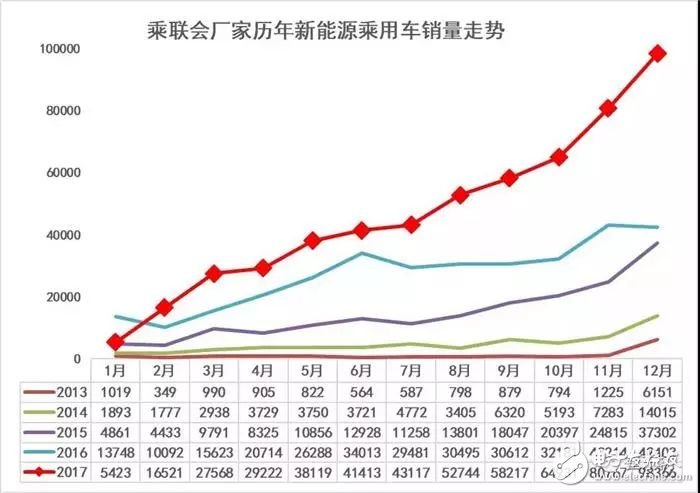According to the manufacturer data of the Association, in December 2017, the sales volume of China's new energy passenger vehicles reached 98,000, a year-on-year increase of 132%, an increase of 16,000 units in November, achieving a continuous growth of 11 months in a year. The cumulative sales volume in December-December was 560,000 units, which increased by more than 70% from the 320,000 units in 2016.
Under the flat performance of the auto market growth rate of only 2.1%, the new energy vehicle has undoubtedly become the most eye-catching section. The annual increment of 200,000 contributed not only to the passenger vehicle market (increased 500,000 units in 17 years). The increase, while its tenacious monthly upward trend compared to the upward trend has also become a rare highlight of the year-round auto market.

Specifically, starting from 0.65 million units in January 2017, the monthly increase in the period from February to December was 11,000 units, 11,000 units, 2 million units, 0.9 million units, 0.3 million units, and 0.2 million units. 9,000 vehicles, 0.5 million vehicles, 0.7 million vehicles, 16,000 vehicles and 16,000 vehicles.
Cui Dongshu, secretary-general of the Association, said that the continuous 11-month continuous pull-up trend was firstly due to the rapid start-up of demand for urban purchases such as Beijing at the beginning of the year, followed by the announcement of the new energy vehicle subsidy announcement and the purchase tax exemption announcement by node. At the same time, more and more manufacturers regard new energy vehicles as the development focus, and constantly introduce new models to promote market growth.
For example, since February 2017, the new energy subsidized product catalogue has been monthly, which has resulted in sales growth since the catalogue began in February. In addition, the five batches of purchase tax catalogues issued in April, July, September, early December and late December, together with the local subsidy policies issued successively, have promoted two rounds of good growth in May and August-December. Among them, the September double-point policy and the release of the fuel consumption points management policy in December 16-17 further encouraged the development enthusiasm of new energy vehicle companies and formed a super-strong situation in September-December.
If we say that in 2017, China's new energy automobile industry is driven by policy, and the 2018 that has already arrived will become the new energy vehicle kinetic energy conversion year. Cui Dongshu said that this year, “the growth momentum of new energy vehicles will shift from policies such as purchase restriction and subsidies to market pull.â€
At present, although there are still new energy vehicle purchase tax in 2018 and three years, the party and government organs take the lead in using new energy vehicles and other favorable policies, but the licenses of Beijing, Shanghai and other cities with restrictions will reach a peak, it is likely There is no license increase; in addition, the new round of central financial subsidy policy will also tend to encourage high-mileage, low-energy vehicles; and the previously rumored cancellation of local subsidies, although in Changsha, Huai'an and other places to release the patching policy Broken, but the gradual tightening of local subsidies has become an indisputable reality. From the 2018 new energy vehicle subsidy standards introduced by cities such as Changsha and Huai'an, the national subsidy of last year has dropped from 50% to 20%-30%.
Losing the license preferential policy will be extremely unfavorable for the increase of medium and large-sized electric vehicles, and the subsidy policy will make the entry-level A00 electric vehicle occupying the largest market share of new energy passenger vehicles in danger. “When the electric light passengers were downgraded, the risk was also likely to be repeated in the A00 low-end mileage model.†Cui Dongshu said.
Therefore, for the sales forecast of the new energy automobile market in 2018, it is frankly pressured and should not be too optimistic. “The non-linear exiting of support policies is too fast, and it is not conducive to industrial development. It is recommended to find an effective link between relevant policies to enhance market adaptability.â€
Communication Zinc Alloy Die Casting
Communication Zinc Alloy Die Casting,Aluminium Casting Mold,Aluminum Alloy Die Casts,Motor Housing Part Pressure Metal
Dongguan Metalwork Technology Co., LTD. , https://www.dgdiecastpro.com